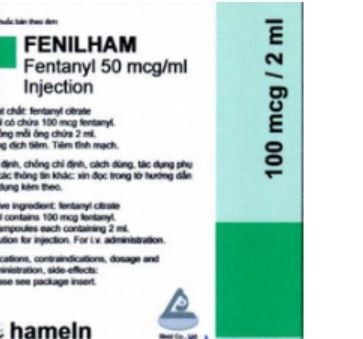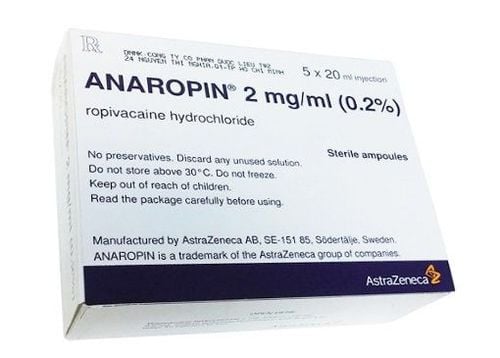This is an automatically translated article.
Escain has the main active ingredient Bupivacaine HCl with a concentration of 5mg/ml. This drug is used in local, regional anesthesia and pain relief. The dosage form of the drug is a solution for injection into the spinal cord. Packing is a box of 5 tubes, each tube contains 4ml.
1. What is Escain?
What is Escain? Escain medicine has the active ingredient Bupivacaine HCl with a concentration of 5mg/ml. This drug is used in local and regional anesthesia and analgesia. The dosage form of the drug is a solution for injection into the spinal cord. Packing is a medicine box of 5 ampoules, each containing 4ml.
1.1. Pharmacodynamics of the active ingredient Bupivacaine HCl The main active ingredient Bupivacaine is a local anesthetic, with an anesthetic effect 2-4 times stronger than that of Lidocaine.
1.2. Pharmacokinetics of the active substance Bupivacaine HCl Absorption: The rate of absorption of the active substance Bupivacaine depends on the total dose and concentration of the drug used, on the mode of anesthesia, distribution, pulse at the injection site and the presence of presence of other active ingredients such as epinephrine in solution for injection. Epinephrine in low concentrations reduces the rate of absorption, allowing a relatively larger total dose and prolonging the duration of local anesthesia. Distribution: Depending on the route of administration, the drug is distributed into all tissues of the body to some extent, the highest concentrations are found in organs with high perfusion such as myocardium, brain, lungs, kidneys, etc. liver. Bupivacaine has a high plasma protein binding capacity (95%). Metabolism: Active substance Bupivacaine is metabolized mainly in the liver, forming 2,6-pipecoloxylidin in the form of conjugates with glucuronic acid. Elimination ability: The drug is excreted mainly in the urine, mostly in the form of metabolites. Only 5% of the active substance Bupivacaine is excreted unchanged in the urine. 1.3 Effect of the active ingredient Bupivacaine HCl Bupivacaine is a local anesthetic of the Amid group, with a long duration of action. The drug acts as a reversible blockade of nerve impulse conduction caused by reducing the permeability of nerve cell membranes to sodium ions. Bupivacaine is more toxic than active ingredients with similar effects such as Mepivacain, Lidocaine or Prilocaine. In terms of duration of action, there is not much difference between Bupivacaine containing and non-epinephrine preparations. This is the active ingredient used to numb the intercostal nerve, pain relief lasts 7 to 14 hours after surgery and can provide good epidural analgesia for 3 to 4 hours. Bupivacaine is also a suitable drug for continuous epidural anesthesia. Bupivacaine without Epinephrine is also used for spinal anesthesia in urology, lower extremities, lower abdomen, and obstetric surgery.
2. What diseases does Escain treat?
Escain is used in regional and local anesthesia and analgesia:
Anesthesia in surgical interventions: Epidural block, regional block (large and small nerves and permeation anesthesia). Analgesia: Perform continuous or interval infusion, position into the epidural space in postoperative or delivery. Regional block (small nerve and injectable anesthetic) Spinal anesthesia: Abdominal surgery lasting 45 to 60 minutes or urological surgery, lower extremities lasting 2 to 3 hours. Lower extremity surgery lasts 3 to 4 hours when muscle relaxation is needed.
3. Usage and dosage of Escain
The dose of Escain varies depending on the area of anesthesia, the vascularity of the tissue, the number of nerve segments to be blocked, the level of anesthetic needed, the tolerability of the individual, the technique of anesthesia. numbness and the patient's condition.
Doses of 400 mg/24 hours are well tolerated in adults (including adrenaline) of average weight 70 kg, healthy, adults. The dose of the drug at any time should not exceed 2mg/kg body weight. Dosage for children under 10 years old is limited. In the elderly, the dose should be reduced. It should be noted that: Dosage as provided above is for reference only. The specific dose will be considered by the doctor on a case-by-case basis. Therefore, the patient should strictly follow the instructions of the doctor and medical staff.
4. Undesirable effects of the drug Escain
During the use of Escain, users may experience undesirable effects, specifically as follows:
For the central nervous system: excitation or inhibition with specific manifestations such as dizziness, nausea, fear, lethargy, confusion, somnolence, ringing in the ears, dizziness, vertigo, vomiting, feeling hot-cold or numb, convulsions, tremors, convulsions, loss of consciousness, depression respiratory and/or respiratory arrest, agitation, slurred speech, slurred speech. The first is exposure to lethargy, loss of consciousness, respiratory arrest. For the cardiovascular system: inhibition slows the heart, lowers blood pressure, cardiovascular collapse leading to cardiac arrest (intravenous catheters should be placed before local anesthetic injection). For hemodynamics: regional anesthesia can lead to hypotension in users. Allergies: skin lesions, urticaria, edema or anaphylactic reactions (with Na metabisulfite). Side effects caused by overdose or accidental injection into the blood vessels affect the central nervous system and/or the cardiovascular system. The mistaken injection of high doses of Escain into the subarachnoid space can cause central nervous system depression, respiratory arrest, and cardiovascular collapse.
5. Escain drug interactions
Be careful when taking Escain with drugs that have antiarrhythmic effects due to the increased potential for effects on the heart.
6. Some notes when using Escain
In the process of using Escain, patients should pay attention to the following issues:
6.1. Escain is contraindicated in the following cases:
People with hypersensitivity to anesthetics of the amide group or drug components. People with diseases of the cerebrospinal system, such as meningitis, tumors, poliomyelitis, subacute spinal degeneration, intracranial hemorrhage... People with spinal bone diseases: tuberculosis , tumors, osteomyelitis, arthritis, spondylitis and other diseases that cannot be punctured. Patients with the disease are accompanied by signs and symptoms of inflammation or infection at the injection site or when there is sepsis. Persons with uncorrected hypotension. People with blood clotting disorders or being treated with anticoagulants. Escain should not be used for intravenous regional anesthesia (Bier block) nor should Escain be used for epidural anesthesia in people with severe hypotension, such as in cases of cardiogenic shock or loss of blood pressure. blood. 6.2. Attention and precautions when using Escain Need to prepare vehicles, resuscitation drugs and oxygen. Inject slowly, aspirate the syringe frequently to minimize the chance of being mistakenly injected into a blood vessel. Pay attention to people with a history of increased sensitivity to the drug. Caution should be exercised in those with severe bradycardia, myocardial conduction disturbances or severe digitalis toxicity. The dose should be reduced for people who are incapacitated, the elderly, people with severe pain or pregnant women. Above is all information about the drug Escain, patients need to carefully read the instructions for use, and strictly follow the instructions of the doctor, medical staff. Absolutely do not arbitrarily buy Escain to treat diseases at home, because there may be unwanted side effects on health.
Follow Vinmec International General Hospital website to get more health, nutrition and beauty information to protect the health of yourself and your loved ones in your family.













